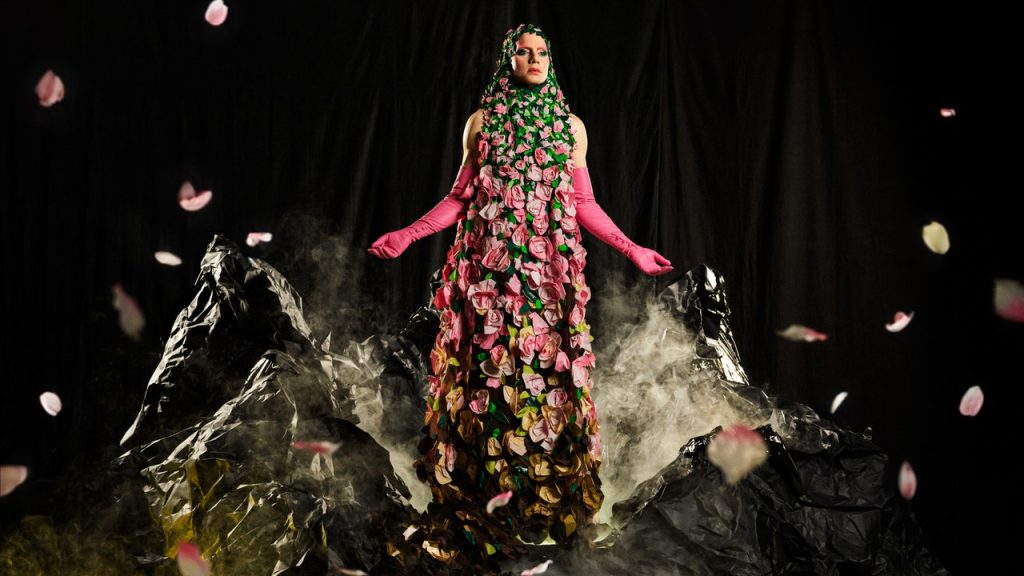Over 20 meters of brown tulle was used for the base of a cape designed by Valentino’s Pierpaolo Piccioli, with 120 meters of silk taffetas in 17 different colors used for roses and leaves applied overtop. The leaves were made from eight meters of lacquered dark green fabric, and the 3-D roses alone required over 1,800 hours of work, while the cape as a whole took 600 hours. This commitment to building emotion and narrative through color is evident in the intricate details of the piece, as it features five different greens and pinks. The cape, which symbolizes the life cycle of a flower, also serves as Piccioli’s final Valentino couture design, adding another layer of meaning to the already emotionally charged garment.
The cape, worn by actor Trevante Rhodes at the Met Gala, evoked a sense of transition and sorrow for the end of an era at Valentino. Roth, who worked closely with Piccioli on the design, felt a deep connection to the garment, which he described as a new understanding of what beauty could be. The intricate details of the cape, from the painstakingly crafted roses to the variety of colors used, exemplify the dedication and artistry of both Piccioli and the atelier. The cape’s significance goes beyond mere aesthetics, tapping into themes of change, growth, and loss that are woven into the fabric of the design.
The cape’s design reflects Piccioli’s dedication to pushing boundaries and exploring new possibilities in couture fashion. By using a variety of fabrics, colors, and techniques, he creates a piece that is not just visually stunning but also emotionally resonant. The choice of materials, from the luxurious silk taffetas to the lacquered dark green fabric, adds depth and texture to the garment, enhancing its overall impact. The painstaking attention to detail, evident in the 3-D roses and delicate leaves, showcases the skill and artistry of the craftsmen and women who brought Piccioli’s vision to life.
Roth’s experience of wearing the cape at the final fitting and the Met Gala underscores the transformative power of fashion. As he describes slipping it on and feeling whole and honest, it becomes clear that clothing can be more than just a piece of fabric; it can be a source of empowerment and self-expression. The emotional resonance of the cape, combined with its intricate design and rich symbolism, elevates it from a mere garment to a work of art. It serves as a testament to the creativity and vision of Piccioli and the atelier, as well as a reminder of the power of fashion to evoke emotion and inspire change.
The choice of Trevante Rhodes as the wearer of the cape further underscores its message of transition and change. As an actor known for his powerful performances and ability to inhabit diverse roles, Rhodes embodies the themes of transformation and growth that are central to the design. His presence at the Met Gala, wearing the cape with confidence and grace, adds another layer of meaning to the garment, turning it into a symbol of resilience and strength. Through his collaboration with Piccioli and the atelier, Rhodes becomes not just a model but a muse, bringing the cape to life in a way that resonates deeply with its themes and symbolism.
In conclusion, the cape designed by Pierpaolo Piccioli for Valentino is more than just a piece of clothing—it is a work of art that evokes emotion, narrative, and meaning. From its intricate design and luxurious materials to its rich symbolism and themes of transition and growth, the cape exemplifies the transformative power of fashion. By wearing the cape at the Met Gala, actor Trevante Rhodes adds another layer of significance to the garment, embodying its themes of resilience and strength. Together, Piccioli, the atelier, and Rhodes have created a piece that transcends mere fashion, becoming a powerful statement on beauty, change, and the endless possibilities of design.


